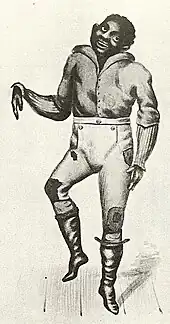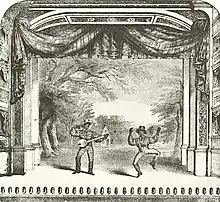
John Diamond (1823 – October 20, 1857), aka Jack or Johnny, was an Irish-American[1] dancer and blackface minstrel performer. Diamond entered show business at age 17 and soon came to the attention of circus promoter P. T. Barnum. In less than a year, Diamond and Barnum had a falling-out, and Diamond left to perform with other blackface performers. Diamond's dance style merged elements of English, Irish, and African dance. For the most part, he performed in blackface and sang popular minstrel tunes or accompanied a singer or instrumentalist. Diamond's movements emphasized lower-body movements and rapid footwork with little movement above the waist.
Diamond was most famous for a series of challenge dances. He regularly advertised that he could defeat all comers in a dancing contest, and he made good on his boasts. However, Diamond soon came to the attention of the dancer whom Barnum had replaced him with, a young black man known as Master Juba. Diamond and Juba fought dance-offs through the mid-1840s; records indicate that Juba won all but one. Accordingly, historian Robert Toll calls Diamond the "greatest white minstrel dancer".[2]
Career
In 1840, Diamond won $500 in a New York City jig competition. Circus proprietor P. T. Barnum took notice and hired the boy, touring him throughout the United States and Europe. Ever the showman, Barnum claimed that the dancer was a mere 12 years old (he was really 17) and billed him as the "King of Diamonds" in advertisements.[3] Diamond performed solo and as part of a pair with blackface singers and musicians. For a time, he was teamed with "the King of Banjo players, and the Emperor of Extravaganza Singers", Billy Whitlock. Their advertisements exclaimed, "Second night of the engagement of the little 'Wirginny Nigger,' only 12 years old, who can outdance the nation, and come some 'Heel and Toe Breakdowns,' that are a caution to all darkies, and no mistake!"[4]
Diamond earned a bad reputation among promoters and managers. One source claimed that his dancing was "considerably better than his temper and disposition."[5] In February 1841, Diamond extorted money from P. T. Barnum and deserted his former mentor to go on a week-long binge of alcohol and women. Barnum sent a letter to his colleagues to caution them against hiring the dancer. Barnum claimed Diamond had "overdrawn the money due him to the amount of $95 and has during the last week expended a hundred dollars in brothels and haunts of dissipation & vice."[6]
Free of Barnum, Diamond played in pairs or groups of three or four blackface performers. In January 1843, he was in a circus with other blackface performers; the program promised "Negro extravaganzas, songs, dances, and locomotive imitations by Whitlock, Diamond, John Daniels and Gardner." The program does not make it clear whether they performed simultaneously or individually.[7] After the Virginia Minstrels formed in 1843, Whitlock convinced Diamond to perform with them in order to increase the group's exposure.[8] In 1845, Diamond was touring the United States with the Old Dominion Circus.[9] In 1849, he was touring with the Olympic Circus.[10] He was still performing regularly in the mid 1850s. Diamond eventually joined the Ethiopian Serenaders minstrel troupe.[11]
Challenge dances
In the 1840s, Diamond began a series of challenge dances wherein he dared his rivals to best him in a contest of skill. Diamond publicized his challenges in popular newspapers. Such trials usually had three judges, one who judged time, one style, and one execution.[12] A typical challenge read:
Master Diamond, who delineates the Ethiopian character superior to any other white person, hereby challenges any person in the world to trial of skill at Negro dancing, in all its varieties, for a wager of from $200.00–$1,000.00.[13]
Diamond won match after match in city after city, and his fame grew exponentially. He earned a host of imitators and copycats, many of whom took his name and pretended to be him.[3]
After their inamicable split, Barnum had replaced Diamond with a young, unknown black man named William Henry Lane. The new protégé took the stage name "Master Juba" and centered his act on imitations of "all the principal dancers in the United States", followed by his own style.[14] Diamond was always the last dancer Juba imitated, as the Irish-American was Juba's only real rival.[15]
Diamond and Juba's war of steps reached a fever pitch when the two agreed to a challenge dance against one another. A series of widely advertised Diamond–Juba dance-offs followed:
Excitement among the Sporting Community—Match between John Diamond and Juba.
The favorites are now the dancers, and he who can cut, shuffle, and attitudanize [sic] with the greatest facility is reckoned the best fellow and pockets the most money.
Match dances are very frequently got up, and seem to give general satisfaction, if we are allowed to judge from the crowds who throng to witness them.
We have not had a real, scientific, out-and-out trial of skill since that between Dick Pelham and John Diamond at the Chatham; but it appears we are soon to have another of these refined and elevating exhibitions.
A match has been made between John Diamond and a little negro called "Juba," by some of the sporting community, and is to come off in the course of a few weeks. The stake is large, and an unparalleled display will be the result.[16]
The Diamond–Juba dance-offs continued through the mid-1840s. Existing records show that Diamond lost all but one.[17]
Dance style

Diamond's repertoire was a mixture of African American, English, and Irish steps.[3] He danced the "five mile out of town dance", the "Long Island breakdown", the "Negro camptown hornpipe", the "ole Virginna breakdown", and the "smokehouse dance". A playbill claimed that his "rattle snake jig" had 120 steps.[18] The steps and maneuvers that made up these dances had equally colorful names; his hornpipe featured the "double shuffle", the "heel and toe", the "pigeon wing", and "running on his heels".[3] His energetic breakdowns were among his more famous dances.[19] Diamond performed in blackface, but some of his dances were strictly British or Irish in origin and were danced without makeup. Examples of these were an Irish jig called the "fireman's hornpipe" and the "naval hornpipe in the character of a Yankee sailor".[20]
Diamond's dances were characterized by little upper-body movement and rapid footwork. He left his upper body relaxed so as to bring attention to his feet. One characteristic step was to lean forward and dangle his hands loosely, look to the side, and slide across the stage with a heel–toe alternation.[21] Noah M. Ludlow, a theatre manager, wrote that "He could twist his feet and legs, while dancing, into more fantastic forms than I ever witnessed before or since in any human being."[22] His playbills proclaimed Diamond a performer of "the greatest display of heel and toe genus [sic] ever witnessed" and that "Now de heels, if dares any music in you, its [sic] got to come out".[13] Diamond's rapid footwork rapped out percussive patterns on the floor. He advertised that he could create music with his heels.[23]
Diamond's act also incorporated singing, either by a partner or by Diamond himself. When partnered with a banjoist, Diamond danced and leapt about the stage while the musician played. These acts involved precise choreography.[24] His repertoire consisted of popular blackface numbers, such as "Jim-a-Long-Josey". He performed stump speeches as well, such as his "Negro speech in Congress".[25]
Notes
- ↑ Hill and Hatch 99.
- ↑ Toll 43. Emphasis added.
- 1 2 3 4 Knowles 86.
- ↑ Vauxhall Gardens announcement in the Morning Herald, New York, July 18, 1840. Quoted in Nathan 62.
- ↑ Knowles 87, see note 19.
- ↑ Quoted in Knowles 88.
- ↑ Circus announcement for the Amphitheatre in the New York Herald, January 19, 1843. Quoted in Nathan 66.
- ↑ Knowles 87.
- ↑ "Old Dominion Circus". American Republican and Baltimore Daily Clipper. Baltimore, MD. 24 December 1845. Retrieved 22 August 2015.
- ↑ "Olympic Circus". The Daily Crescent. New Orleans, LA. 5 February 1849. Retrieved 22 August 2015.
- ↑ Day 49.
- ↑ Knowles 89.
- 1 2 Playbill, New Theatre, Mobile, February 24, 1841. Quoted in Knowles 87.
- ↑ Playbill for "Master Juba . . . and the Ethiopian Minstrels", 1845. Quoted in Nathan 113.
- ↑ Knowles 88.
- ↑ New York Sporting Whip, January 28, 1843. Quoted in Cockrell 138.
- ↑ Knowles 90; Toll 43.
- ↑ Playbill for the Ordway's Aeolians, Boston, January 2, 1852. Quoted in Nathan 83.
- ↑ Cockrell 88.
- ↑ Announcement of Vauxhall Gardens in the Morning Herald, New York, July 29, 1840, and playbill of the New Theatre, Mobile, February 24, 1841. Quoted in Nathan 95–6.
- ↑ Nathan 61–2.
- ↑ Quoted in Knowles 86–7; see footnote 6.
- ↑ Nathan 73.
- ↑ Nathan 64.
- ↑ New Theatre playbill, Mobile, February 24, 1841. Printed in Nathan 61.
References
- Cockrell, Dale (1997). Demons of Disorder: Early Blackface Minstrels and Their World. Cambridge University Press. ISBN 0-521-56828-5.
- Day, Charles (1996). "Fun in Black", Inside the Minstrel Mask: Readings in Nineteenth-century Blackface Minstrelsy. Wesleyan University Press. ISBN 0-8195-6300-5.
- Hill, Errol G., and James V. Hatch (2003). A History of African American Theatre. Cambridge University Press. ISBN 0-521-62443-6.
- Knowles, Mark (2002). Tap Roots: The Early History of Tap Dancing. McFarland & Company. ISBN 0-7864-1267-4.
- Mahar, William J. (1999). Behind the Burnt Cork Mask: Early Blackface Minstrelsy and Antebellum American Popular Culture. Chicago: University of Illinois Press. ISBN 0-252-02396-X.
- Nathan, Hans (1962). Dan Emmett and the Rise of Early Negro Minstrelsy. Norman: University of Oklahoma Press. ISBN 0-8061-0540-2.
- Toll, Robert C. (1974). Blacking Up: The Minstrel Show in Nineteenth-century America. New York: Oxford University Press. ISBN 0-19-502172-X.
- Vaudeville, old and new By Frank Cullen, Florence Hackman, Donald McNeilly